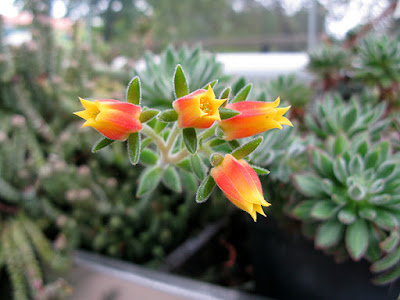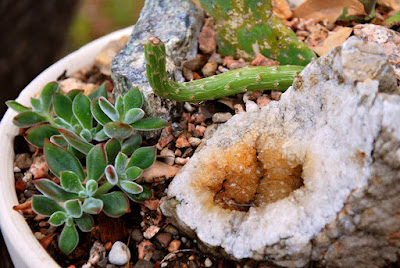Echeveria harmsii - Plush Plant have a rosette of light-green to dark green, hairy leaves with red hue margins and tips that deepens with sun stress.
Echeveria harmsii, also called as Plush Plant, Red Echeveria, Cotyledon elegans, Echeveria elegans, Oliveranthus elegans, Oliverella elegans, is a species in the Echeveria genus. This species was described by James Francis Macbride in 1934 and was named for the German botanist Hermann A.T. Harms.
ECHEVERIA HARMSII - PLUSH PLANT DESCRIPTION
Echeveria harmsii is native to Mexico. It is found growing on rocky outcroppings in Estado de México, Oaxaca, Hidalgo and was first found in cultivation at Amecameca, Estado de México, Mexico, 1901.
It is a succulent plant which reaching 30-50 cm in height that branching throughout, densely pubescent with a a petite rosette that are closely set near the ends of young branches and gradually falling away below. The leaves are oblanceolate to spatulate, thick, but flattened except at base, acute, pubescent, 2-3 cm long, light-green to dark green, hairy with red hue margins and tips that deepens with sun stress.
Plush Plant blooms in spring from the slender, 10 cm long, 1-2 flowered, racemose inflorescences with some scattered leaves. The flowers are bell-shaped, bright red with yellow tips, up to 3 cm long and are loved by hummingbirds. Its show-stopping chromatic skills will also be loved in event décor.
ECHEVERIA HARMSII - PLUSH PLANT CARE AND CULTURE
Cultural information should only be used as a guide, and should be to be adapted to suit you. Your physical location; where you grow your plants, how much time you have to devote to their care, and many other factors, will need to be taken into account. Only then can you decide on the cultural methods that best suit you and your plants.
Light:
Echeveria harmsii grows well in full or partial sun. It do best at a southern, eastern or western exposure. When the plant doesn’t get enough light, it starts growing tall, become stretched and lose their color, their leaves are sparse around a long, thin stem. This means the plant is reaching for light. If you grow the plant on a windowsill, turn the plant occasionally to ensure that all sides of your plant get enough sun.
In the middle of summer, keep it bright but skip the very hot, and burning western sun, which can fry them. Also, the dramatically changing amount of the sunlight is a stress source for your plants. If you are going to move your outdoor succulents to the interior places, do it gradually.
Although excess water is what most often kills it, it also likes having a lot of light, but not scorching direct sun, as when behind a window. If the foliage gets sunburned, the best thing to do is behead the plant, and grow a new one, taking off the damaged leaves.
Temperature:
Plush Plant make the great floor covering plants for the rock gardens. However, if kept outside, they will require a temperate climate all year long. They are very tender to cold and sudden drop in the temperature, in particular among the other succulents. But if you live where winters get real, you can still enjoy these beautiful succulents by growing them in interior pots instead, or move them to indoors for the freezing winters. The biggest concern about growing the plant, like many succulents, indoor spaces is that they will not get as much sunlight as they do outside.
During the spring and summer months, your indoor succulents need temperatures of between 65 and 80°F (18-27°C). During the winter, a few degrees lower will be ideal. You can grow the plants outside if you have warm summers of at least 19°C or 20°C.
Substrate and growing media:
Echeveria harmsii require a well-draining, porous growing medium to help keep excess moisture away from the roots. Standard cactus potting mixes are sufficient for the plants, which can be found at most nurseries and garden centers.
When grow the plant in a pot or container, it is important to choose the right size. As a rule of thumb for all succulents, choose a pot that is just larger than the root ball. This helps to ensure soil doesn’t stay too damp. Don’t place your plant in a pot without the drainage holes on the bottom.
You may repot your plant just after purchasing it if you’ve purchased it while it wasn’t flowering. After that, an annual repotting in spring with soil mix amended with sand will surely extend the lifespan of your plant. Re-potting in spring in a pot that is slightly larger than the previous will extend the lifespan of your plant. To repot the plant, ensure that the soil is completely dry before removing it from its potting container. Carefully remove the excess soil from the roots before placing the plant in its new pot.
Watering:
Watering is the most important aspect of proper care. Like most succulents, they do not require much water. During the blooming, 1 to 2 waterings a week, only when the soil has dried well. Apart from the blooming season, 1 to 2 waterings a fortnight. In winter, light watering 1 time a month is largely enough. Allow the soil to become dry between waterings. Under cool temperatures, keep both the soil and foliage dry. Humidity is not an issue as they are dry land plants that can tolerate wide swing with little difficulty.
You should water the plant once in a while, but pouring a big amount. Keep water running through the soil until it is completely wet and let the soil drain all the water inside. They do not like to stay in a wet soil. Repeat this watering process if needed. After you water your plant, you should wait a long period of time in order the plant use all the water storage inside its body.
If you notice that leaves are falling off, are wilting, turning yellow, or turning brown, it could be an issue with watering. Too much watering or too little watering can all affect the health of your plant.
Fertilizer:
Echeveria harmsii have low fertilizer needs coming from areas of low fertility where most soil has washed away. Adding a flower plant fertilizer will help extend the blooming and increase its beauty. Feed once a month with a dilute solution like a 15-15-15 or lower in summer when temperatures are warm and light is high. Reduce or eliminate fertilizer in winter or to control size.
Pruning:
Little need for pruning except in old plants. Plants can be pruned back when height is excessive for a particular growing situation, tops can be cut out and side branching will develop, eventually forming a full plant. Remove wilted flowers regularly (deadheading). This step isn’t mandatory but it will help stimulate the plant to produce new flowers.
Rest period:
Plush Plant grow mainly in spring and summer and nearly cease growing in autumn and winter (their dormant period). They usually have a problem period in April and May where they transition from the growing period, to the dormant period. Fungal problems become more prevalent as the older leaves start to shrivel be reabsorbed and die back for winter. If the plants have had too much water in Autumn the lower old leaves will not shrivel but die and begin to rot this can spread to other leaves ultimately to the stem where it can take over the plant.
Propagation:
Echeveria harmsii produces small suckers at the base of stems, and these can be replanted and take root easily. Simply remove cleanly from the mother plant, let callus for a few days until the wound has closed and place on soil or in water and wait for roots to develop. Roots usually grow first to seek out water, followed by new leaves. This may take anywhere from a week to a few months and there is no need to water propagating succulents as they will glean all the nutrition and moisture they require from their mother leaf, which will shrivel up over time. The original leaf may be gently removed once it has dried up and become crispy in texture, only remove if it comes away easily otherwise you risk damaging the baby plant.















COMMENTS